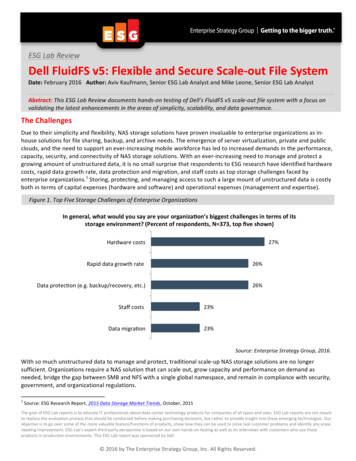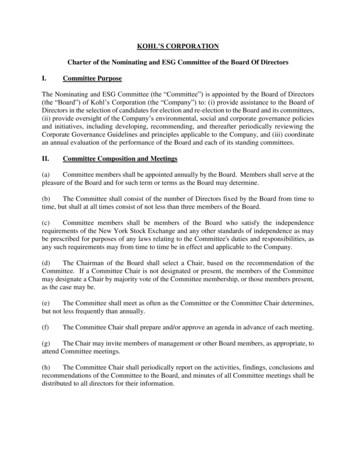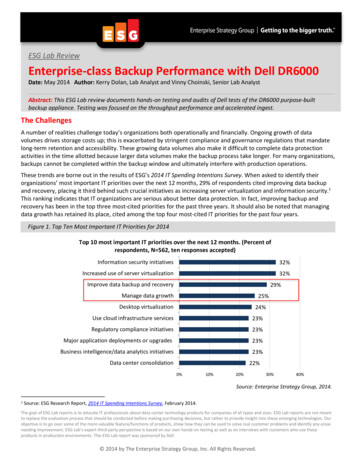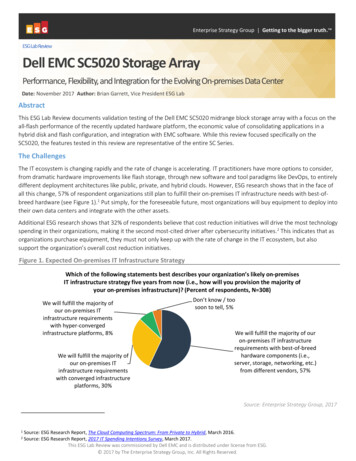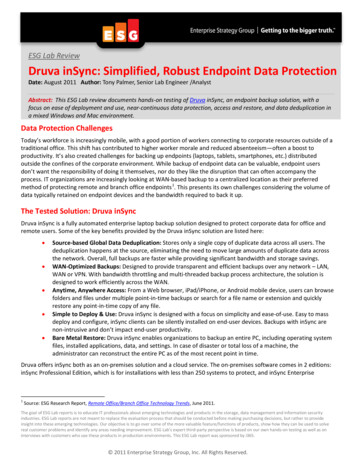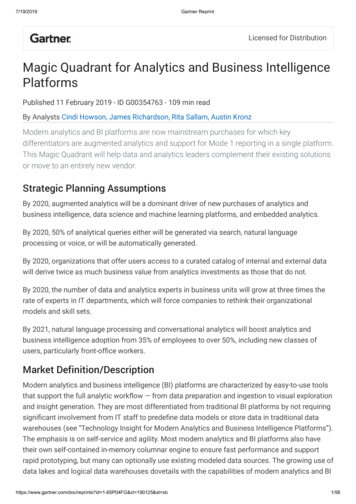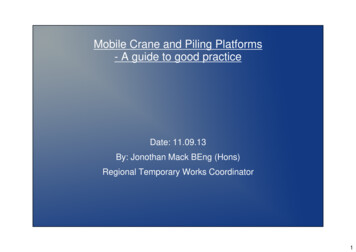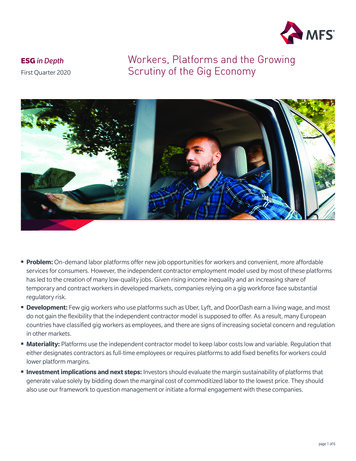
Transcription
ESG in DepthFirst Quarter 2020Workers, Platforms and the GrowingScrutiny of the Gig Economy§§ Problem: On-demand labor platforms offer new job opportunities for workers and convenient, more affordableservices for consumers. However, the independent contractor employment model used by most of these platformshas led to the creation of many low-quality jobs. Given rising income inequality and an increasing share oftemporary and contract workers in developed markets, companies relying on a gig workforce face substantialregulatory risk.§§ Development: Few gig workers who use platforms such as Uber, Lyft, and DoorDash earn a living wage, and mostdo not gain the flexibility that the independent contractor model is supposed to offer. As a result, many Europeancountries have classified gig workers as employees, and there are signs of increasing societal concern and regulationin other markets.§§ Materiality: Platforms use the independent contractor model to keep labor costs low and variable. Regulation thateither designates contractors as full-time employees or requires platforms to add fixed benefits for workers couldlower platform margins.§§ Investment implications and next steps: Investors should evaluate the margin sustainability of platforms thatgenerate value solely by bidding down the marginal cost of commoditized labor to the lowest price. They shouldalso use our framework to question management or initiate a formal engagement with these companies.page 1 of 6
ESG in DepthFirst Quarter 2020ProblemIt is true that labor platforms facilitate trusted digital transactions between strangers — economicallyand at scale —which creates value for various stakeholders:Workers: The platforms enable workers to find new jobs, utilize excess capacity (e.g., time and assets)and allow workers greater flexibility and control over their time.Consumers: Consumers often benefit from lower prices, increased convenience and choice, and fewerasset ownership needs (e.g., cars).Government: The government benefits from higher employment, the resulting tax revenues and asmaller informal economy.1However, given the lack of pricing power for discretionary services like ride sharing and food delivery,platforms are not incentivized to compensate drivers fairly, leading to very low average hourly earningsand few benefits offered to drivers. Low pay and poor benefits often force drivers to work excessivehours, negating one of the gig economy’s purported benefits, namely, flexibility.The risk of a regulatory response related to these concerns is increased by society’s growing focus onincome and wealth inequality. Various data sets suggest many developed markets have experiencedan increase in income inequality over the past few decades. This is due to many factors, includingthe decline of labor unions and greater focus on corporate profitability, which have contributed to anincrease in temporary and contract work. Temporary and contract work tends to be lower-quality jobswith fewer benefits, further increasing income volatility for workers. The gig economy is an outgrowth ofthis trend, and the generally poor treatment of workers by platforms is leading to the additional scrutinyof temporary and contract employment.DevelopmentThe two biggest problems with the way platforms treat labor are 1) workers cannot earn a living wageand 2) platforms exert excessive control over workers.Living wage: While many platforms claim to pay workers a minimum wage, they do not pay them a livingor a fair wage. A living wage is one that ensures minimum acceptable living standards, sufficient to coverthe cost of necessities such as health care. A fair wage takes this premise further by requiring that wagesand benefits are paid regularly and on time, ensuring excessive hours are not necessary to earn a livingwage, etc.Exhibit 1Minimum WageLiving WageFair WageSet by government Some companies sethigher minimums Ensures minimum acceptableliving standards Sufficient to cover cost ofnecessities such as health care A wage paid regularly and on timeDoes not require excessive hours Rises with the cost of living orindividual advancement Enables saving for long term needs page 2 of 6
ESG in DepthFirst Quarter 2020Because platforms do not disclose wage data — or any data for that matter — it is very difficult to evaluatehow they are paying workers.However, a study conducted by the JPMorgan Chase Institute, which evaluated trends in the onlineplatform economy across 27 US metro areas, showed a 40% or greater decline in monthly driverrevenues between 2013 and 2018 in a majority of the areas surveyed.2 We believe this points to an excesssupply of drivers and a reduction in driver incentives, which would lower driver earnings sharply.Exhibit 2: Change in average monthly revenues on transportation platformsfrom Jan–Oct 2013 to Jan–Oct 2018 2013 2018-87%Bridgeport, CT-79%Dallas, TX-36%New York, NYAtlanta, GA-80%Seattle, WA-43%San Francisco, CA-27%Everywhere Else-74%Denver, CO-58%San Diego, CA-62%Las Vegas, NV-60%San Jose, CA-35%Miami, FL-71%Los Angeles, CA-54%-69%Phoenix, AZChicago, IL-23%Detroit, MI-43%-58%Indianapolis, INColumbus, OH-44%Houston, TX-45%-21%Portland, ORAustin, TX-6% 0 1,000 2,000 3,000 4,000 5,000Source: The Online Platform Economy in 27 Metro Areas: The experience of drivers and lessors,JPMorgan Chase Institute, 2019.While most workers do not rely solely on gig work, 20% to 30% do.3 These workers are at greater riskof exploitation by platforms given information asymmetry and the likely cyclicality of wages based onmacroeconomic activity. Should the economy enter a recession, this pool of “precarious” labor is likely toexpand materially, attracting regulatory attention.Excessive market power and influence: Platforms are the only stakeholders with complete controlover the data generated by workers and users. Allegedly, some have engaged in unethical behaviorsuch as using data to manipulate consumer or worker behavior. For example, some platforms havebeen accused of removing pricing information from heat maps to lure workers to accept jobs thatmay be undesirable.4page 3 of 6
ESG in DepthFirst Quarter 2020Given these two concerns, we created a framework to evaluate both labor earnings and platforminfluence and control. Key questions include the following: Are pay algorithms fair, and does platform pass on 100% of tips to workers? Is the ratings process fair or are workers unfairly penalized? Do platforms provide fair and effective accident insurance? Can workers earn a living wage while retaining flexibility?Although these types of companies are not incentivized to pay labor well, their behaviorsvary ivers penalized despite unreasonably short deliverywindows. Low tip pass-through. Bad culture.BUSCourier-13Insufficient earnings opportunity, excessive reliance on lowtips. Ineffective live help.CUSFood Delivery-8Drivers not paid for long waits; hurdles for minimum /hr toohigh. No insurance.DUSFood Delivery-5Unclear if drivers receive full tip. Benefits weak, especiallyinsurance. Review system unfair.EUSRide Share-4To earn a living wage drivers have to drive 9–12 hrs/day,reducing flexibility. Weak benefits.FUSRide Share-1To earn a living wage drivers have to drive 9–12 hrs/day,reducing flexibility. Benefits improving.GUSFood Delivery0Can earn a living wage with sufficient bonus/incentives(sustainable?).HUKFood Delivery3No penalties for drivers, tips earned in cash and a fair payalgorithm but very few benefits provided.IUKFood Delivery10Fair pay algorithm, enough work for drivers, good benefits &review system — but these are recent improvements!JEuropeFood Delivery12Employees covered by contract through temp agency; nopenalties, good benefits. Health & safety training.Source: MFS original research. The scoring methodology for this framework is based on three categories, each of whichincludes various sub-themes, that MFS evaluates for each company. The three categories are: fair Pay (e.g., speed of driveraccess to cash flow from their work), driver benefits (e.g., insurance), and driver support (e.g., driver grievance processes).MaterialityWhile platforms argue that consolidation could help resolve both high cash burn from incentives andlow worker earnings, there are several counters to this argument.First, platforms propose to increase worker revenue by acquiring new consumers through consolidation,thereby increasing the number of trips per driver.5 They do also aim to increase driver revenue byconsolidating different types of delivery, (e.g., transporting passengers) as well as food. However, asplatforms continue to cut incentives, these solutions would likely require drivers to work more hoursand make more drops to earn the same wage and could result in continued driver turnover.page 4 of 6
ESG in DepthFirst Quarter 2020Second, collective bargaining is not effective in the gig economy model because the market is toofragmented. Gig economy companies are lobbying to prevent workers from unionizing, and the everexpanding size of the workforce, along with driver fragmentation, has rendered strikes ineffective.6Lawsuits have not resulted in sustained improvements for workers given the massive power imbalancebetween companies and workers. As a result, it is likely that companies would retain most of the benefitsof consolidation.As a result, there is a growing need for regulation. Even the United States and the United Kingdom — theleast-regulated developed markets in terms of labor — are beginning to show signs of change. Severalstates in the US are piloting regulations that protect independent workers, requiring portable benefits,minimum wages, IRA plans and paid leave for gig workers. Some states, including California, areconsidering reclassifying independent contractors as employees.7 This kind of regulation is likely tocreate financially material impacts on platform company margins over the intermediate and long term.Next stepsWe suggest that investors carefully evaluate the margin sustainability of platforms that, as describedabove, generate value solely by bidding down the marginal cost of commoditized labor to the lowestprice. Platforms that improve worker treatment proactively while monetizing other parts of the businessinstead are likely to be more sustainable. Investors should also use the company comparison frameworkto initiate a formal engagement with management teams.page 5 of 6
ESG in DepthFirst Quarter 2020Endnotes ork that is neither reported to a government nor taxed. The informal economy decreases tax revenues and provides no regulatoryWoversight or employee protections.2 Farrell, Diana, Fiona Greig, and Amar Hamoudi. “The Online Platform Economy in 27 Metro Areas: The experience of drivers and lessors”JPMorgan Chase Institute, 2019.3 Source: nd-the-gig-economy.4Source: conomy-uber-information-and-power.5Source: MFS original research.6Source: bor-unions-ab5-california.7 Since the internal distribution of this research at MFS, Assembly Bill 5 was passed in California and took effect January 1, 2020. The lawredefines workers as employees if their job is part of a company’s core business, or if they meet a variety of other criteria.1ESG in Depth is an internal research series produced for the benefit of MFS investment professionals. Although some ESG in Depth communications are made available externally toillustrate the thematic research regularly produced by and for our investment team, all suggestions in the document are directed at MFS investment professionals, not the general public.This research was initially presented to the MFS investment team on July 14, 2019.Please keep in mind that a sustainable investing approach does not guarantee positive results.The views expressed are subject to change at any time. These views are for informational purposes only and should not be relied upon as a recommendation to purchase any security or as asolicitation or investment advice from the Advisor.The views expressed are those of the author(s) and are subject to change at any time. These views are for informational purposes only and should not be relied upon as a recommendation topurchase any security or as a solicitation or investment advice from the Advisor.Unless otherwise indicated, logos and product and service names are trademarks of MFS and its affiliates and may be registered in certain countries.Distributed by:U.S. - MFS Investment Management; Latin America - MFS International Ltd.; Canada - MFS Investment Management Canada Limited. No securities commission or similar regulatory authorityin Canada has reviewed this communication.Please note that in Europe and Asia Pacific, this document is intended for distribution to investment professionals and institutional clients only.U.K. - MFS International (U.K.) Limited (“MIL UK”), a private limited company registered in England and Wales with the company number 03062718, and authorized and regulated in theconduct of investment business by the U.K. Financial Conduct Authority. MIL UK, One Carter Lane, London, EC4V 5ER UK provides products and investment services to institutional investors.This material shall not be circulated or distributed to any person other than to professional investors (as permitted by local regulations) and should not be relied upon or distributed to personswhere such reliance or distribution would be contrary to local regulation; Singapore - MFS International Singapore Pte. Ltd. (CRN 201228809M); Australia/New Zealand - MFS InternationalAustralia Pty Ltd (“ MFS Australia”) holds an Australian financial services licence number 485343. MFS Australia is regulated by the Australian Securities and Investments Commission.;Hong Kong - MFS Internation
§ Development: Few gig workers who use platforms such as Uber, Lyft, and DoorDash earn a living wage, and most do not gain the flexibility that the independent contractor model is supposed to offer. As a result, many European countries have classified gig workers as employees, and there are signs of increasing societal concern and regulation
